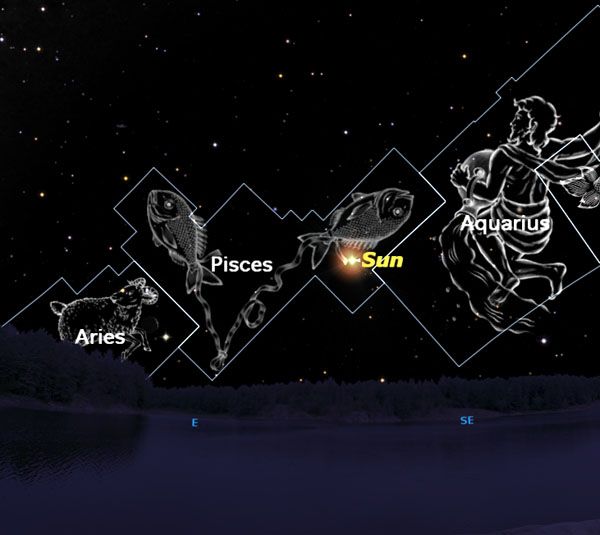Astrology: Why Your Zodiac Sign and Horoscope Are Wrong

It's a great conversation starter: "What's your sign?" But before you ask or answer that question, consider this: Your Zodiac sign corresponds to the position of the sun relative to constellations as they appeared more 2,200 years ago! The science behind astrology may have its roots in astronomy but don't confuse these two disciplines. Astronomy can explain the position of the stars in the sky but it's up to you to determine what, if anything, their alignment signifies. In short, as you'll see below, your Zodiac sign is not what you think it is, and your corresponding horoscope can't be right. [Related: Wobbly Earth Means Your Horoscope Is Wrong]
The constellations of the Zodiac
The ecliptic, or the path of the sun as it's perceived from the revolving Earth, passes through the constellations that formed the Zodiac: Aries, Taurus, Gemini, Cancer, Leo, Virgo, Libra, Scorpio, Sagittarius, Capricorn, Aquarius and Pisces. Astrologers skip a 13th constellation that also resides on the ecliptic: Ophiuchus.
Babylonian astrologers, and later the Greeks, originally determined Zodiac signs by which constellation the sun was "in" on the day you were born. Early astronomers observed the sun traveling through the signs of the Zodiac in the course of one year, spending about a month in each. Thus, they calculated that each constellation extends 30 degrees across the ecliptic.
Ancient astrologers grouped the 12 signs according to the classical elements. The elements represent certain personality traits and are used in conjunction with the star signs, as well as with the position of the sun, moon and known planets at the time, to determine a horoscope, according to Astro.com:
Fire — Aries, Sagittarius, Leo (spontaneous and impulsive)
Water — Cancer, Scorpio, Pisces (imaginative and emotional)
Air — Libra, Aquarius, Gemini (quick and animated, tendency to intellectualize feelings)
Earth — Capricorn, Taurus, Virgo (quiet and slow reactions, slow to change emotionally)
However, a phenomenon called precession has altered the position of the constellations we see today and has resulted in a shift of the zodiac constellations.
Precession and astrology
The first day of spring in the Northern Hemisphere was once marked by the zero point of the Zodiac. Astronomers call this the vernal equinox and it occurs as the ecliptic and celestial equator intersect on approximately March 21.
Around 600 B.C., the zero point was in Aries and was called the "first point of Aries." The constellation Aries encompassed the first 30 degrees of the ecliptic; from 30 to 60 degrees was Taurus; from 60 to 90 degrees was Gemini; and so on for all 12 constellations of the Zodiac.
Unbeknownst to the ancient astrologers, Earth continually wobbles around its axis in a 25,800-year cycle. This wobble — called precession — is caused by the gravitational attraction of the moon on Earth's equatorial bulge.
Over the past two-and-a-half millennia, this wobble has caused the intersection point between the celestial equator and the ecliptic to move west along the ecliptic by 36 degrees, or almost exactly one-tenth of the way around, to the border of Pisces and Aquarius. This means that the signs have slipped one-tenth — or almost one whole month — of the way around the sky to the west, relative to the stars beyond.
For instance, those born between March 21 and April 19 consider themselves to be Aries. Today, the sun is no longer within the constellation of Aries during much of that period. From March 11 to April 18, the sun is actually in the constellation of Pisces!
Your 'real sign'
The table below lists the dates when the sun is actually within the astronomical constellations of the Zodiac, according to modern constellation boundaries and corrected for precession (these dates can vary a day from year to year).
You will most likely find that once precession is taken into account, your Zodiac sign is different. And if you were born between Nov. 29 and Dec. 17, your sign is actually one you never saw in the newspaper: you are an Ophiuchus! The ecliptic passes through the constellation of Ophiuchus after Scorpius.
Check out your "real" zodiac sign, based on the sun's current path, and compare it to the date still used by astrologers (in parentheses):
Capricorn — Jan. 20 to Feb. 16 (Dec. 23 to Jan. 21) Aquarius — Feb. 16 to March 11 (Jan. 22 to Feb. 20) Pisces — March 11 to April 18 (Feb. 21 to March 19) Aries — April 18 to May 13 (March 20 to April 20) Taurus — May 13 to June 21 (April 21 to May 21) Gemini — June 21 to July 20 (May 22 to June 22) Cancer — July 20 to Aug. 10 (June 23 to July 22) Leo — August 10 to Sept. 16 (July 23 to Aug. 22) Virgo — Sept. 16 to Oct. 30 (Aug. 23 to Sept. 22) Libra — Oct. 30 to Nov. 23 (Sept. 23 to Oct. 22) Scorpio — Nov. 23 to Nov. 29 (Oct. 23 to Nov. 22) Ophiuchus — Nov. 29 to Dec. 17 (not included in the Zodiac) Sagittarius — Dec. 17 to Jan. 20 (Nov. 23 to Dec. 22)
Additional reporting by Rachel Ross, Live Science Contributor
Additional resources
- Astro.com is a compendium of information about astrology and horoscopes
- The BBC answers the question: "Which stars were you really born under?"
- Understanding Science, a website developed by the University of California Museum of Paleontology, asks the question: "Astrology: Is it scientific?"
Sign up for the Live Science daily newsletter now
Get the world’s most fascinating discoveries delivered straight to your inbox.













